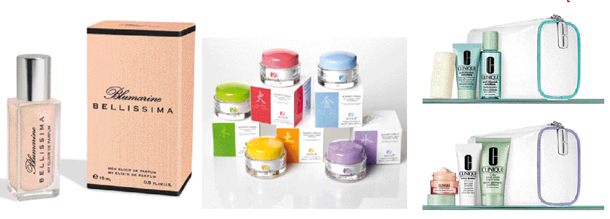How cosmetics packaging is changing
Facts and Figures The Italian perfumery-cosmetics market registers figures that go against those of many other industrial sectors. Exports are doing well, so too Italian domestic demand. Packaging thanks duly and follows suite.
In 2011, the year of general crisis, the Italian cosmetics industry continued its positive growth trend, registering an overall increase in sales of 4.6%. Crucial here the strong performance of exports (+14%), but Italian domestic demand for cosmetics is also seen to be lively: even in the presence of a general downsizing of consumption, Italian domestic demand grew by +4.6%, thus confirming the non cyclical vocation of the sector.

The Italian market
The growth of the Italian market is derived from an increase of 1% in Italian products and a 5% increase of imported cosmetics and perfumery.
The trade balance is seen to be positive: +1,050 million euros in value and +188,123 in tons.
33% of Italian exports are headed towards four countries, namely Germany, France, UK and USA.
Still considering the year 2011, exports to Hong Kong, UAE, Poland and Spain show the highest growthrates.
While going through a difficult economic situation, the Italian companies have continued to invest in research and innovation.
The structure of the offer confirms that four sectors (body care 17%, facial care 15%, hair care 14% and bodily hygiene 14%) account for 60% of the offer.
These are followed by the important area of men's and women’s perfumes, with a share of 12%.
The remaining 28% comprise a number of areas: oral hygiene, make-up, products for hands and lips, men's products, dermal products for children and gift boxes.
Each of these product areas uses a varied range of packaging.
72% of products are used by women and 28% by men (whose consumption in recent years has shown interesting growth trends).
According to calculations made by the Istituto Italiano Imballaggio, in 2011 the output of the various cosmetics and perfumery products entailed the use of 3.37 billion packs: +4,2% compared to 2010 that in turn marked a +3,3% compared to 2009.
This growth confirms a decidedly favourable overall market picture; cosmetics and perfumes are confirmed as products that “create image”, where product presentation, as well as all that concerns communication, is seen to be strategic given the special features of the sector.
In addition to performing its standard function of product container, packaging constitutes a powerful marketing tool to communicate sensations, associated both with the product as well as with the producing company.

Focus on primary packaging
It is estimated that in 2011, the Italian cosmetics - perfumery and personal care industry placed 3.37 billion packs on the market: extremely varied the types of primary packaging, more homogeneous those for presentation and transport (for presentation packaging the choice essentially falls on the folding cardboard carton, the corrugated cardboard packing case being favoured for transport packaging).
The primary packaging used by the perfume-cosmetics and personal hygiene sector can be grouped into five main categories: glass packaging, plastic packaging (including flexible laminates), flexible tubes, metal tins and paper wrapping.
Glass. Glass containers (bottles, flasks, jars, etc.) have a global share of 23.6% of total primary packaging used for packaging the various cosmetics products.
Over the last ten years the share of the glass containers has dropped from 28% to 23.6% but in the last two years its position seems to have stabilized.
The greatest presence of glass is in the perfume industry, where the bottles cover a share of 89%, glass is also used for packaging hand care products.
Plastics. The main competitor of glass packaging generally speaking is plastic packaging, where jars, bottles, rigid tubes feature impressive growth rates.
The market share of plastic packaging is 42.9% and is tending to grow (it has put in an annual average growthrate of 1% since the year 2000).
Plastic packaging is most prominent in hair care products, standing at 75%, comprising 58% of body care packaging, its proportion for facial and make-up products standing at 64%, lipstick 65%, deodorants 50% and hand care products 35%.
The share of laminated materials, both rigid and flexible, is showing progressive growth.
Flexible PE/AL/PE tubes account for an approximate 18.9% of the overall share, a figure which is substantially stable; PE/AL/PE is used in 85,7% of toothpaste packaging.
Flexible converter polylaminates (practically speaking monodose pouches), account for a share of 3.8% of the market, their share is tending to grow in the hand care and perfumery segments.
Metal. As for the metal packaging (spraycans, tins, rigid tubes, etc..) they are grouped under aluminium and steel: The former account for 6%, the latter 3.3% of packaging used in the sector.
The deodorant sector makes the most use of the same: the metal spraycan accounts for 34% of packaging used, which can be broken down into aluminium standing at 30%, and steel accounting for the 4%, confirming prevailing market trends.
Metal aerosols also show a significant presence in the shaving foam segment: aluminium accounting for a share of 25% and steel a share of 15%.
Aluminium is also used to produce flexible tubes (2%) still used in different areas of cosmetics, although the market is oriented towards the flexible polylaminate tube.
Paper. Primary paper packaging comprising paper pouches (talcum power), and paper wrappers (soaps) is seen to be stable, accounting for 1.5% of total packaging used in the sector.
Note on presentation packaging. The folding carton cases, secondary packaging presentation by definition, is still very popular: used in about 45% of packaging, one calculates a use of 1400 million units. In the case of high-end perfumes and face and body creams, like the bottle or jar, the carton plays a highly important communicative function.
Plinio Iascone
Istituto Italiano Imballaggio




















